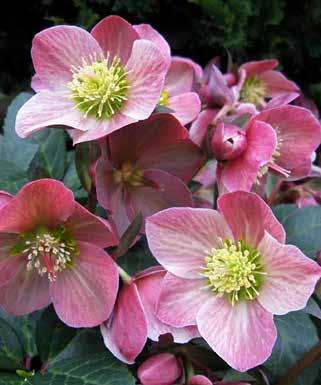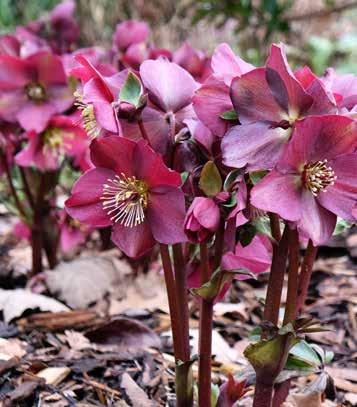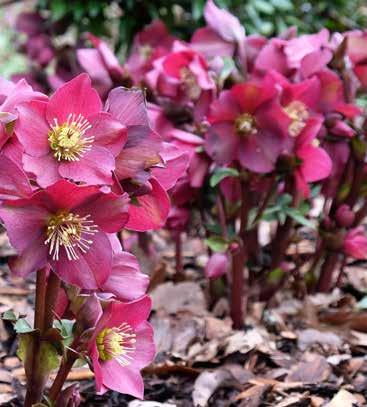
3 minute read
Diane Walton
Hellebores
The Roses of Winter
Advertisement
BY DIANE WALTON
Hellebores are perennial plants that have evergreen foliage and colorful flowers, which are frost-resistant. The shape of the bloom resembles that of a rose, and some hellebores commonly are called the winter rose or Lenten rose. Bloom time depends on the species and the climate. However, the Lenten rose usually flowers around the period of Lent, blooming in the winter and into the spring, with blooms lasting two to three months.
Much breeding has occurred with hellebores, and many cultivars are available. Flowers come in many colors, ranging from pure white to a deep, blackish purple. Some boast spotted or speckled blooms, and some cultivars bear doubled flowers.
The easiest way to add a hellebore to your garden is to purchase a plant, or get a cutting from an existing plant. If you decide to use seed, be sure to collect seeds from the pods and plant them in a container, or somewhere outdoors during the summer months. Keep the soil moist, and you should have new plants the following winter or spring. If you decide to keep the seeds to plant later, they will go dormant and have to be stratified before planting, which may not work. When incorporating hellebores into your garden, consider planting location, soil, water, maintenance and division. 1. Planting location. Hellebores can grow in partly shady areas or in full shade (under trees). The plants need only a few hours of sun each day and do not tolerate full afternoon sun. Hellebores self-sow, and new plants may appear, but this is not an invasive plant. Clumps slowly expand by rhizomatous roots. The plants grow to 2 feet high and 2 feet wide.
2. Soil. Soil needs to be rich with organic matter and well-draining. I have not used fertilizer, only compost and mulching, and my hellebores have been growing with beautiful blooms for the past five years. You can use an organic rich fertilizer if you do not have compost. If using this method, fertilize in the spring and early fall, but don’t over fertilize.
3. Water. Hellebores are tolerant of dry soil, and will rot if they sit in water-soaked ground, so they do not need watering daily or weekly. I water my plants, if we have not had rain in 10-plus days, with stored rainwater only at the base of the plant.
4. Maintenance and division. You do not need to prune a hellebore unless you want to pull off the dead leaves. I have never trimmed mine. Maintenance is very minimal, which is one reason why I love this plant. You may want to propagate your hellebores, which can be done by division.

Pink hellebores provide a pop of color in a winter landscape.

The best time to divide a plant is before flowering. I usually propagate in September or October. Dig up the entire plant and divide it, making sure you have two or more buds on the divided plant. Plant one portion back where it was previously, and plant the others in your garden, or put in a pot and give to neighbors and friends to enjoy.
Note: The sap in hellebores can irritate skin, so wear gloves when pruning or propagating.
The hellebore is not susceptible to many bug infestations, but aphids are the biggest problem. Aphid infestation can bring black death disease, which causes black streaks. Remove and toss out the plant if this happens. Treat the plants for aphids, so they do not spread to other plants.
Hellebores are poisonous, and ingestion by a pet should not be fatal, but can result in illness. The taste is very bitter, so a pet probably would not eat a great amount. However, even though they are toxic, deer, rabbits and squirrels have been known to eat them.
Since hellebores bloom early in the winter or spring, I plant companion plants around them, so I have continually flowering plants. I use hostas and coral bells. Other plants that can be used are native ferns, columbines and bleeding hearts.
Who says you can’t have flowers in winter? Try planting hellebores to add colorful life to winter gardens.
Diane Walton has been a Cherokee County Master Gardener for the past 14 years. She held the position of treasurer for 10 years and has presented several gardening seminars.









